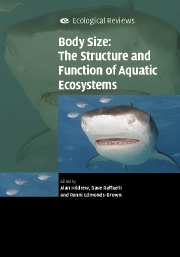Book contents
- Frontmatter
- Contents
- List of contributors
- Preface
- 1 The metabolic theory of ecology and the role of body size in marine and freshwater ecosystems
- 2 Body size and suspension feeding
- 3 Life histories and body size
- 4 Relationship between biomass turnover and body size for stream communities
- 5 Body size in streams: macroinvertebrate community size composition along natural and human-induced environmental gradients
- 6 Body size and predatory interactions in freshwaters: scaling from individuals to communities
- 7 Body size and trophic cascades in lakes
- 8 Body size and scale invariance: multifractals in invertebrate communities
- 9 Body size and biogeography
- 10 By wind, wings or water: body size, dispersal and range size in aquatic invertebrates
- 11 Body size and diversity in marine systems
- 12 Interplay between individual growth and population feedbacks shapes body-size distributions
- 13 The consequences of body size in model microbial ecosystems
- 14 Body size, exploitation and conservation of marine organisms
- 15 How body size mediates the role of animals in nutrient cycling in aquatic ecosystems
- 16 Body sizes in food chains of animal predators and parasites
- 17 Body size in aquatic ecology: important, but not the whole story
- Index
- References
9 - Body size and biogeography
Published online by Cambridge University Press: 02 December 2009
- Frontmatter
- Contents
- List of contributors
- Preface
- 1 The metabolic theory of ecology and the role of body size in marine and freshwater ecosystems
- 2 Body size and suspension feeding
- 3 Life histories and body size
- 4 Relationship between biomass turnover and body size for stream communities
- 5 Body size in streams: macroinvertebrate community size composition along natural and human-induced environmental gradients
- 6 Body size and predatory interactions in freshwaters: scaling from individuals to communities
- 7 Body size and trophic cascades in lakes
- 8 Body size and scale invariance: multifractals in invertebrate communities
- 9 Body size and biogeography
- 10 By wind, wings or water: body size, dispersal and range size in aquatic invertebrates
- 11 Body size and diversity in marine systems
- 12 Interplay between individual growth and population feedbacks shapes body-size distributions
- 13 The consequences of body size in model microbial ecosystems
- 14 Body size, exploitation and conservation of marine organisms
- 15 How body size mediates the role of animals in nutrient cycling in aquatic ecosystems
- 16 Body sizes in food chains of animal predators and parasites
- 17 Body size in aquatic ecology: important, but not the whole story
- Index
- References
Summary
Introduction
June 9th, having received early in the morning some rain-water in a dish … and exposed it to the air about the third story of my house … I did not think I should then perceive any living creatures therein; yet viewing it attentively, I did, with admiration, observe a thousand of them in one drop of water, which were the smallest sort that I had seen hitherto.
(From a letter written in 1676 by Antonie van Leeuwenhoek, who had a passion for designing and building ‘magnifying glasses’.)Leeuwenhoek was almost certainly the first person to see protozoa and other microfauna, and the first to record their huge population sizes. He could not explain how the microbes got into the ‘dish of rainwater’, and this rather disappointing level of understanding has not changed much in 300 years.
The debate is rather polarized. On one hand are those who draw attention to the possibility that a significant proportion of free-living microbial species may be geographically restricted (examples include Mann & Droop, 1996; Foissner, 1999). On the other hand are those who recognize that this is at odds with the alternative hypothesis that neutral dispersal of small organisms is driven by extraordinarily large numbers of the individuals themselves. Although the probability of an individual microbe being transported over great distance is vanishingly small, a multitude of interacting processes and events, both common and rare (hurricanes, transport in wet fur and feathers, etc., in combination with huge population sizes, are expected to drive large-scale dispersal across all spatial scales.
- Type
- Chapter
- Information
- Body Size: The Structure and Function of Aquatic Ecosystems , pp. 167 - 185Publisher: Cambridge University PressPrint publication year: 2007
References
- 8
- Cited by



